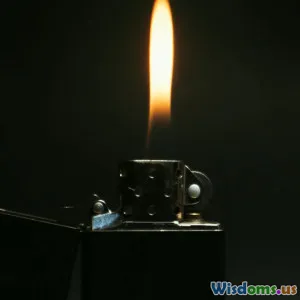
Beginner Mistakes That Could Turn Any Adventure Into a Disaster
8 min read Avoid common beginner mistakes that can turn your adventure into disaster. Learn tips to stay safe and enjoy every journey. (0 Reviews)
Beginner Mistakes That Could Turn Any Adventure Into a Disaster
Adventures evoke excitement, promise new experiences, and offer a chance to escape routine life. But for beginners, the thrill can quickly turn into chaos if mistakes are made. Whether exploring a mountain trail or setting off on a road trip, overlooking critical planning or safety measures can transform a dream adventure into a nightmare. This article dives into common beginner missteps that cause disasters, supported by real-world examples and expert advice, so you can avoid pitfalls and embrace the thrill safely.
The Allure and Risks of Adventure
Adventure inevitably carries risk—the allure is grounded in stepping beyond the comfort zone. According to the Outdoor Industry Association, around 53 million Americans engage in hiking at least once per year, but nearly 85,000 search and rescue operations occur annually related to outdoor activities in the U.S. alone. Often, these rescues result from avoidable errors stemming from lack of preparation or overconfidence.
Understanding these risks is the first step. Experienced adventurers emphasize: “Adventure requires respect for nature’s unpredictability and humility in your planning.” — Sarah Gibson, Outdoor Safety Expert.
Common Beginner Mistakes That Compromise Adventures
1. Insufficient Planning and Research
Heading out without knowing the terrain, weather patterns, or local hazards can have serious consequences. For instance, tourists who hike Arizona’s Grand Canyon without checking temperature warnings or route difficulty sometimes suffer heat stroke and exhaustion—a preventable hazard.
Research encompasses:
- Trail difficulty and length
- Weather forecasts and seasonal changes
- Emergency contacts and evacuation routes
- Local wildlife or plant dangers
Failing to do this means venturing blindly into challenges beyond your abilities.
2. Overestimating Physical Capabilities
Beginners often underestimate how physically demanding an activity might be. The National Park Service reports that many injury calls stem from people attempting strenuous hikes without adequate conditioning.
Physical preparation means:
- Building endurance progressively
- Understanding your limits
- Considering altitude impacts
Ignoring these can cause fatigue, exacerbate injuries, or trigger panic, which worsens any situation.
3. Packing Inappropriately
Another frequent error is poor packing. Packing too much can weigh you down, while forgetting essential gear can leave you stranded. For example, trekkers in cold regions sometimes neglect proper thermal layers, resulting in hypothermia risks.
Essentials typically include:
- Appropriate clothing layers
- Navigation tools (maps, GPS)
- First aid kit
- Water and food supplies
- Shelter or communication devices
No item is trivial; every piece contributes to safety and comfort.
4. Ignoring Safety Protocols
Disregarding established safety advice is a recipe for disaster. Whether crossing rivers without checking depth or climbing unstable rocks—these choices put adventurers at unnecessary risk.
Authorities recommend:
- Informing someone about your itinerary
- Adhering to marked trails
- Avoiding risky shortcuts
- Watching for weather changes
One small lapse can quickly escalate into emergencies demanding costly rescues.
5. Relying Excessively on Technology
While gadgets like smartphones and GPS units aid navigation, a blind faith in technology can backfire. Batteries die, signals drop, or devices malfunction. When electronics fail, lack of traditional navigation skills becomes a critical problem.
Adventurers should always:
- Carry physical maps and know how to read them
- Use compasses as backup
- Have manual emergency tools like whistles or mirrors
Technological aids are valuable but never substitute fundamental survival knowledge.
6. Underestimating Environmental Conditions
Weather and natural elements don’t adapt to your plans. Sudden storms, temperature drops, or unexpected terrain features easily challenge unprepared individuals.
For example, inexperienced hikers caught in flash floods during thunderstorms in mountainous regions often face life-threatening situations.
Key lessons include:
- Continuous weather monitoring
- Having contingency plans
- Knowing escape routes
Respecting nature’s volatility is non-negotiable for any safe adventure.
Real-World Examples of Beginner Errors Turned Disaster
-
In 2019, nine hikers needed rescuing from Colorado’s Maroon Bells after ignoring trail advisories about sudden thunderstorms, leading to severe hypothermia in some cases. The rescue cost thousands and delayed emergency services.
-
An unprepared cyclist attempting a remote desert route in Nevada during summer suffered from dehydration when water supplies ran out. His lack of planning and communication devices prolonged rescue efforts.
-
Tourists hiking in New Zealand’s Tongariro Crossing ignored posted volcanic activity warnings and were exposed to dangerous fumes, requiring urgent evacuation.
These incidents confirm how crucial informed preparation is.
Practical Tips to Avoid Beginner’s Pitfalls
- Thoroughly Research Every Aspect: Use official guides, local expert advice, and updated weather apps.
- Plan Realistic Itineraries: Match activities to your fitness and experience level.
- Pack Light but Smart: Prioritize essentials based on environment and duration.
- Learn Basic Survival Skills: Map reading, first aid, signaling distress.
- Never Go Alone: Traveling with companions increases safety.
- Inform Others About Your Plans: Ensure someone knows where you’ll be and when you’re expected back.
- Stay Informed During the Adventure: Check weather updates, trail conditions regularly.
Following these guidelines transforms curiosity-driven excursions into safe, enjoyable adventures.
Conclusion: Adventure’s Thrill Demands Responsibility
Adventure embodies exploration’s spirit but comes with inherent risks best addressed by learning from beginner mistakes. Preparation, respect for nature, and realistic self-assessment not only prevent disasters but enrich your experience. As famed mountaineer Sir Edmund Hillary said, “It is not the mountain we conquer but ourselves.” Embrace humility in planning and readiness, and every adventure can remain a cherished memory rather than a cautionary tale.
Ultimately, smart adventuring empowers you to discover the joys of the unknown while keeping safety as your steadfast companion.
Rate the Post
User Reviews
Popular Posts




















